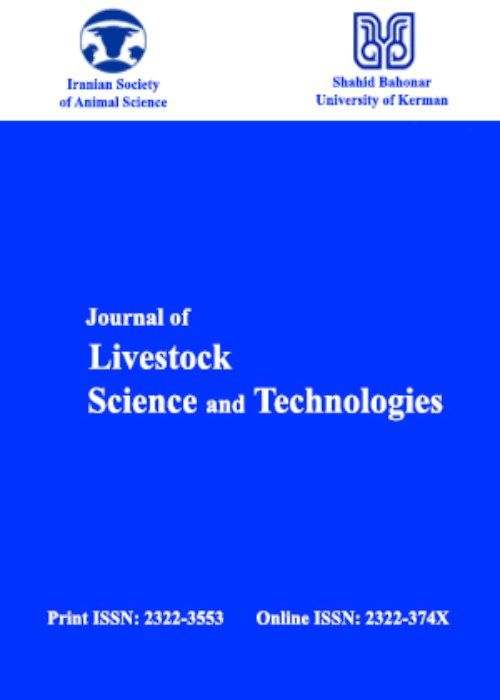In ovo and dietary feeding of betaine to broiler chickens under heat stress conditions: Effects on hatchability, performance, body temperature and blood parameters
Author(s):
Article Type:
Research/Original Article (دارای رتبه معتبر)
Abstract:
The effects of in ovo feeding (0 and 1g/L) and dietary feeding (0 and 1g/kg diet) of betaine on hatchability, performance, body temperature and blood parameters of broiler chicks under heat stress condition, were investigated using 600 fertile eggs (Ross 308) for in ovo injection at 17.5d of incubation. After hatching, 192 male chickens were divided into four groups: 1- In ovo feeding of non-betaine solution and post-hatch diet without betaine, 2- In ovo feeding of non-betaine solution and post-hatch dietary feeding 1g per kg of betaine, 3- In ovo feeding of 1g per L betaine solution and post-hatch diet without betaine, and 4- In ovo feeding of 1g per L betaine solution and post-hatch dietary feeding 1g per kg of betaine. The chicks were exposed to heat stress from 7-28d for 4h/d. The results showed that body weight of hatched chicks and the hatched chick body weight to initial egg weight ratio, was significantly increased by in ovo feeding of betaine (P<0.05). The effects of in ovo feeding and dietary feeding of betaine resulted in higher feed intake (P<0.05) and daily weight gain (P<0.01) and improved feed conversion ratio (P<0.05) for 7-21d. Birds that received dietary betaine had more carcass, breast and leg weight than chickens receiving betaine-free diet at 28d (P<0.05). The experimental treatments had no significant effect on carcass yield at d 42. During heat stress between 14 and 21d age, the group that did not receive betaine (in ovo or dietary) had the highest cloacal temperature (P<0.01). The concentration of high-density lipoproteins, triglycerides and cholesterol in the blood of chickens that received betaine-free diet was significantly higher than other groups (P<0.05). In general, dietary betaine feeding improved the performance and carcass parameters and decreased blood lipids and cloacal temperature of chicks under heat stress conditions. However, these effects were not observed from days 28 to 42, which were free of heat stress.
Keywords:
Language:
English
Published:
Journal of Livestock Science and Technology, Volume:10 Issue: 2, Dec 2022
Pages:
37 to 46
magiran.com/p2528503
دانلود و مطالعه متن این مقاله با یکی از روشهای زیر امکان پذیر است:
اشتراک شخصی
با عضویت و پرداخت آنلاین حق اشتراک یکساله به مبلغ 1,390,000ريال میتوانید 70 عنوان مطلب دانلود کنید!
اشتراک سازمانی
به کتابخانه دانشگاه یا محل کار خود پیشنهاد کنید تا اشتراک سازمانی این پایگاه را برای دسترسی نامحدود همه کاربران به متن مطالب تهیه نمایند!
توجه!
- حق عضویت دریافتی صرف حمایت از نشریات عضو و نگهداری، تکمیل و توسعه مگیران میشود.
- پرداخت حق اشتراک و دانلود مقالات اجازه بازنشر آن در سایر رسانههای چاپی و دیجیتال را به کاربر نمیدهد.
دسترسی سراسری کاربران دانشگاه پیام نور!
اعضای هیئت علمی و دانشجویان دانشگاه پیام نور در سراسر کشور، در صورت ثبت نام با ایمیل دانشگاهی، تا پایان فروردین ماه 1403 به مقالات سایت دسترسی خواهند داشت!
In order to view content subscription is required
Personal subscription
Subscribe magiran.com for 70 € euros via PayPal and download 70 articles during a year.
Organization subscription
Please contact us to subscribe your university or library for unlimited access!



